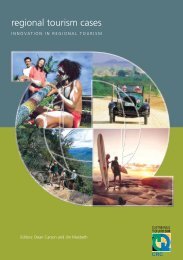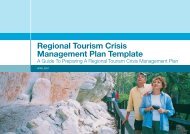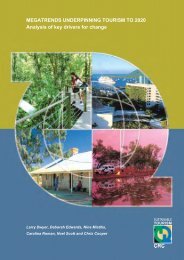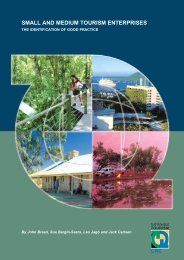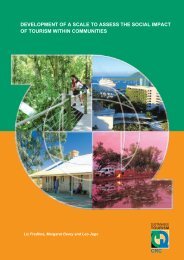Tourism Risk Management - Sustainable Tourism Online
Tourism Risk Management - Sustainable Tourism Online
Tourism Risk Management - Sustainable Tourism Online
Create successful ePaper yourself
Turn your PDF publications into a flip-book with our unique Google optimized e-Paper software.
Disasters in Asia and the Pacific<br />
Many Asian countries, especially those in South East Asia, are densely populated and prone to<br />
disasters which have a severe and negative effect upon their economies and development. Countries<br />
with long coastlines are repeatedly affected by cyclones (typhoons); floods are an annual feature in<br />
the region claiming lives and destroying huge areas of land in India, Indonesia and Bangladesh; flash<br />
floods are common in hilly and mountainous regions; seismic disturbances are very common in Asia;<br />
and in India the entire sub-Himalayan region is prone to earthquakes.<br />
Landslides are increasingly common in hilly and mountainous regions causing extensive damage to<br />
roads, bridges, human dwellings, and land as well as loss of human lives. Volcanic eruptions have<br />
recently caused significant death and destruction. Diverse agro-climactic conditions account for the<br />
frequent occurrence of droughts in India, Pakistan, Burma and Indonesia, while regular epidemics of<br />
enteric diseases such as cholera, typhoid, respiratory infections, and vector-borne diseases are<br />
common. Cyclones and floods are seasonal events in the Pacific, while volcanic activity and<br />
earthquakes are additional and significant sources of risk to communities.<br />
Disasters in Asia and the Pacific are also caused by civil disturbance, terrorism and transportation<br />
accidents.<br />
Transport Incidents<br />
Transport incidents such as bus crashes, train derailments and ferry accidents are relatively routine<br />
emergencies throughout the developed world, yet when victims include a significant number of<br />
international visitors they generate a high level of media attention. The degree of media coverage<br />
often relates to the frequency, scale, and severity of the incident (particularly the number of injuries<br />
and fatalities); however, such publicity often serves to engender negative destination images and<br />
perceptions.<br />
Although tourism and destination officials are not directly responsible for these incidents, the<br />
circumstances often warrant close scrutiny of accepted safety conditions and standards. Recent<br />
high profile bus crashes in Egypt (January 2006) have been attributed to speed and poor road<br />
conditions, while the visitor-chartered ferry that capsized off Bahrain killing 44 people in March 2006<br />
was reportedly unstable and unlicensed. Similar incidents cite causes such as overcrowding,<br />
insufficient safety equipment, poor operational conditions and general negligence. Ferry incidents<br />
and motorbike accidents had become so common in Thailand during 2005 that the Australian<br />
Government began officially to warn potential travellers of the hazards involved in using these forms<br />
of transport.<br />
While many countries have legislated minimal safety standards, compliance and maintenance is<br />
often the responsibility of individual operators. As part of a proactive risk management process,<br />
individual businesses should endeavour to review and implement best practice safety procedures,<br />
as government and industry should pressure dangerous operators to conform through enforcement<br />
of safety codes and legal requirements.<br />
Common preventative strategies for businesses and operators include:<br />
• regular safety audits of vehicles/equipment/facilities;<br />
• scheduled inspection, maintenance and repairs;<br />
• employee safety training/certification;<br />
• reviewing and adherence to minimum safe operational conditions eg, maximum capacity,<br />
46 <strong>Tourism</strong> <strong>Risk</strong> <strong>Management</strong> – An Authoritative Guide to Managing Crises in <strong>Tourism</strong>



